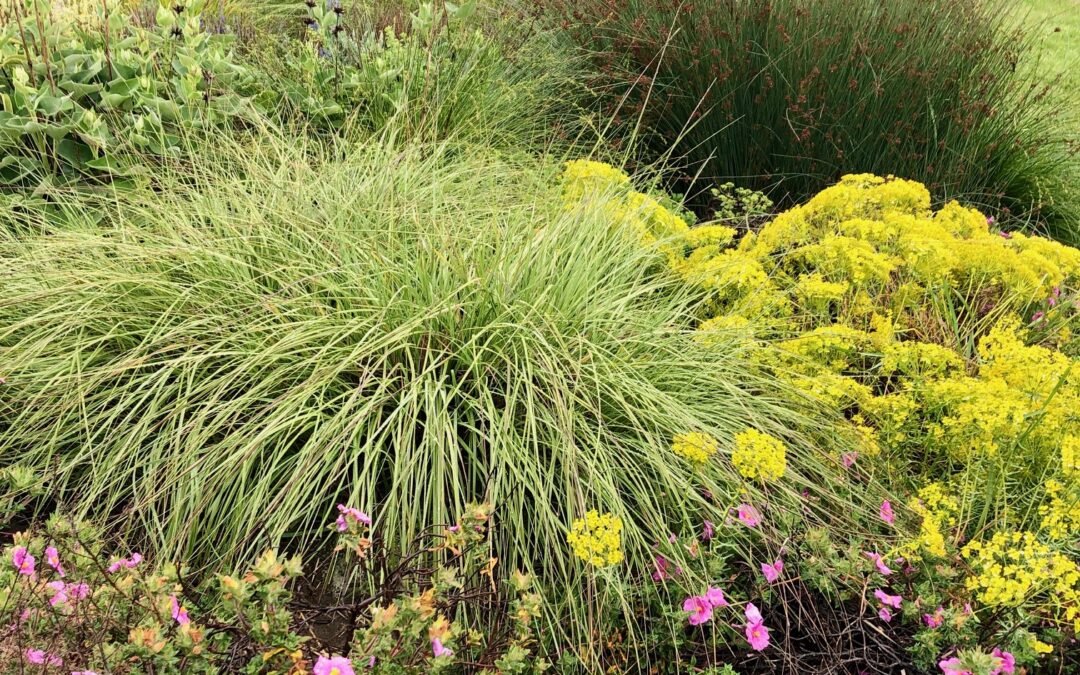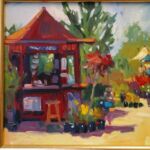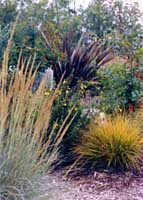 With silky flowers that ripple in the slightest breeze, or soft billowy mounds that provide cover for birds, ornamental grasses can bring fine or bold texture and a sense of motion to any garden. Grown in a mass, or interplanted with trees and shrubs and flowers, ornamental grasses add interest to perennial beds and the wild garden. The term ‘ornamental grasses’ generally includes both true grasses and plants of similar character, like sedges (Carex sp.), rushes (Juncus sp.) and the South African restio (Chondropetalum tectorum). These plants share the characteristics of blade-like leaves, and flowers with no petals. Generally, the varieties sold by nurseries form clumps, but some ornamental grasses also spread by runners.
With silky flowers that ripple in the slightest breeze, or soft billowy mounds that provide cover for birds, ornamental grasses can bring fine or bold texture and a sense of motion to any garden. Grown in a mass, or interplanted with trees and shrubs and flowers, ornamental grasses add interest to perennial beds and the wild garden. The term ‘ornamental grasses’ generally includes both true grasses and plants of similar character, like sedges (Carex sp.), rushes (Juncus sp.) and the South African restio (Chondropetalum tectorum). These plants share the characteristics of blade-like leaves, and flowers with no petals. Generally, the varieties sold by nurseries form clumps, but some ornamental grasses also spread by runners.
Grasses interplanted with flowers can really accent flower colors and provide fine texture and presence when the more ephemeral flowers stop blooming. Watching grasses sway in light breezes can be mesmerizing; listening to them rustle can be delightful. Grasses come with leaves of many colors – brown, blue gray, bright green, rusty orange, white variegated, striped yellow, and burgundy.
Ornamental grasses each have their own distinctive character and form and one must ask basic questions to determine the life strategy of the individual plant. Grasses can be annual or perennial. Annual kinds grown for their showy flowers typically are started from seed. At Sierra Azul we grow perennial species. Grasses can be deciduous or evergreen and there are advantages to the gardener in either strategy. The evergreen grasses provide a strong presence throughout the year; often these plants are most appreciated in the winter when the other flowers in the garden are not at their best. The everbrown New Zealand sedges (Carex buchananii, C. flagellifera, C. testacea) are especially nice in the quieter times of the garden year. The spiky, blue gray Helictotrichon sempervirens and the low, arching Calamagrostis foliosa look good all year. Periodic ‘combing’ with your fingers can often remove the old and dead blades that accumulate in the clumps over time. This practice is not necessary with all cultivars, and is not recommended for those cultivars whose leaves have sharp edges.
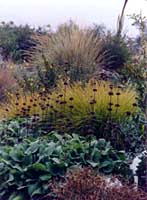 Deciduous grasses can bring valuable fall color to the garden. Panicum virgatum ‘Haense Herms’ colors purple and reddish in fall; some Miscanthus cultivars have red and orange tints. Miscanthus cultivars, with the exception of Miscanthus transmorrisonensis, are deciduous, but their upright columnar or somewhat arching form makes them prized additions to the garden. M. s. ‘Variegatus’ is a column of green and white and grows to 6′ in a season. The narrow blades of M. s. ‘Morning Light’ are cream and gray, and make a tight misty gray column. These cultivars are topped with tasselly plumes in late summer. Many gardeners leave clumps standing through the winter; still quite attractive when dried and tan, they sound their best in late fall and winter. It is very important to cut Miscanthus clumps down in February so that the new blades can make an easy and neat appearance. Watching your clump grow to 5-6′ in a season is truly amazing. Another advantage of deciduous grasses is that they need little grooming, as you remove all foliage every year. Some grasses form discrete clumps; others are known to spread at the root. Most ornamental grasses are clumping; some exceptions are Japanese Blood Grass (Imperata cylindrica ‘Rubra’) and Elymus condensatus ‘Canyon Prince’. Neither of these grasses are aggressive spreaders, but this characteristic is important to consider when choosing a grass. Some grasses spread readily by seed, and while this is a valuable trait in some situations, it can cause problems in a small or closely planted garden. The delightful Stipa tenuissima and the California native Stipa pulchra are two species that seed around.
Deciduous grasses can bring valuable fall color to the garden. Panicum virgatum ‘Haense Herms’ colors purple and reddish in fall; some Miscanthus cultivars have red and orange tints. Miscanthus cultivars, with the exception of Miscanthus transmorrisonensis, are deciduous, but their upright columnar or somewhat arching form makes them prized additions to the garden. M. s. ‘Variegatus’ is a column of green and white and grows to 6′ in a season. The narrow blades of M. s. ‘Morning Light’ are cream and gray, and make a tight misty gray column. These cultivars are topped with tasselly plumes in late summer. Many gardeners leave clumps standing through the winter; still quite attractive when dried and tan, they sound their best in late fall and winter. It is very important to cut Miscanthus clumps down in February so that the new blades can make an easy and neat appearance. Watching your clump grow to 5-6′ in a season is truly amazing. Another advantage of deciduous grasses is that they need little grooming, as you remove all foliage every year. Some grasses form discrete clumps; others are known to spread at the root. Most ornamental grasses are clumping; some exceptions are Japanese Blood Grass (Imperata cylindrica ‘Rubra’) and Elymus condensatus ‘Canyon Prince’. Neither of these grasses are aggressive spreaders, but this characteristic is important to consider when choosing a grass. Some grasses spread readily by seed, and while this is a valuable trait in some situations, it can cause problems in a small or closely planted garden. The delightful Stipa tenuissima and the California native Stipa pulchra are two species that seed around.
Even without showy petals, some grasses are prized for their flowers as well as their general character. Deer Grass (Muhlenbergia rigens) has a particularly fine form. The evergreen foliage clump is about a foot tall; midsummer brings many narrow, stiff, erect flower spikes. These spikes rise to about 5′, and give the plant a star-burst effect. The South African Chondropetalum tectorum holds its dark green horsetail-like blades all year, and carries black flowers in spring and summer. Little shiny golden brown bracts along the stems add to the picture. The stems of this plant are quite sturdy, and a clump of Chondropetalum rippling in the breeze is a gardener’s delight. The widely planted Red Fountain Grass (Pennisetum setaceum ‘Rubrum’) is admired for its striking dark red foliage as well as its pink plumy flowers. In some local areas it will be evergreen; with more frost it is deciduous. It will look its best if cut back hard after danger of frost has passed in early spring.
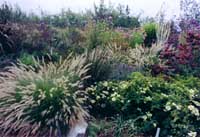 Most grasses tend to be fairly adaptable and responsive to garden conditions. Good soil and abundant water will bring lush and fast growth; more lean conditions cause slower growth. Most of the above-mentioned grasses do best in sun, but there are many grasses suited to part shade or shade. The brown New Zealand sedges will grow in sun or shade in coastal gardens; the Common Woodrush (Luzula sylvatica) shows off its wide glossy blades best in shady gardens. Sesleria caerulea is a low clumping blue-green grass that looks neat in sun or light shade.
Most grasses tend to be fairly adaptable and responsive to garden conditions. Good soil and abundant water will bring lush and fast growth; more lean conditions cause slower growth. Most of the above-mentioned grasses do best in sun, but there are many grasses suited to part shade or shade. The brown New Zealand sedges will grow in sun or shade in coastal gardens; the Common Woodrush (Luzula sylvatica) shows off its wide glossy blades best in shady gardens. Sesleria caerulea is a low clumping blue-green grass that looks neat in sun or light shade.
Many gardeners use ornamental grasses to cover problem areas, since some varieties are so forgiving of poor conditions. Alkali Sacaton (Sporobolus airoides) will grow in wet, heavy soils and withstand summer drought, although it looks best with occasional water. Midsummer brings pinkish cloudy flower clusters over the 18″ foliage clump of this tough grass. Berkeley Sedge (Carex tumulicola) makes a low, glossy green mound and will grow in sun or part shade. Best with occasional summer water, it also will tolerate winter wet soils, and is often used as ground cover under trees or to create a ‘meadow’ planting.
Clearly grasses deserve more attention and use in the garden and through their wide variety of form, size, color, texture and growth requirements offer the gardener many choices.

